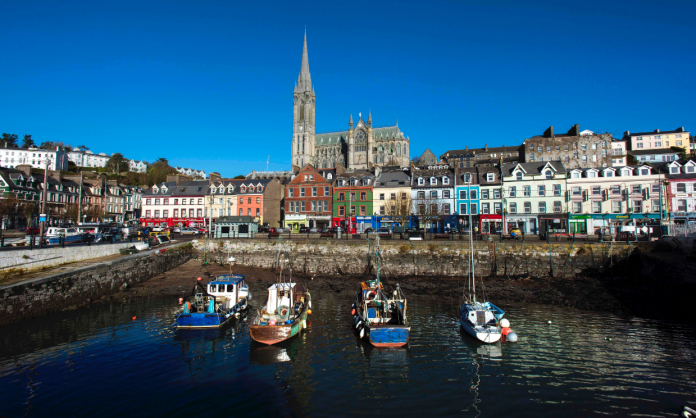By Peter P Dobbing
In time, everything changes. On my first visit to Cobh in the 1970’s it was like stepping back in time. I thought it a wonderful place, but whatever it had been it certainly was not that any longer.
The harbour, one of the deepest and best in the world was bereft of big ships but one can easily imagine the ocean liners and great battleships at anchor. Facing the water there were a series of splendid hotels, mostly now disused but I stayed in one, The Commodore.
The steady climb to St. Colman’s Cathedral passing the Lusitania Graves memorial, is something beyond me today (at 81) but I’m thankful to have done it. St. Colman’s is magnificent. Having visited the town many times over the years I have seen it recover and change to a thriving holiday location.
Located more or less in the centre of Cobh harbour is Spike Island. Once dark and foreboding but now nicely rounded off by the passage of the years and a new tourist attraction. Originally the site of a monastic settlement the island is today dominated by the 18th century Fort Mitchel.
The evidence for a monastic foundation on the island is a trifle vague, credence being given to St. Mochuda establishing a monastery in AD 635. Certainly a church was known to exist on the island in 1774. Moving on from St. Mochuda to almost modern times the island has seen two main uses: as a fortress and as a prison.
In the 1600’s Spike Island was used by smugglers for the import and export of contraband and by Cromwell as a staging post for the transfer of prisoners being transported to Bermuda. During the 18th century the island had numerous owners both English and Irish but in 1770 the government rented first part and then all for military use.
In 1779 a substantial artillery fortification was considered, this prompted by the American Revolution and the entry of France and Spain into the war on the American side. At the time Cork harbour was an assembly point for ships bound for the Americas and these were literally sitting ducks for potential attackers. The Spike Island Battery comprised eighteen 24 pound cannon, a formidable deterrent.
In 1802 Colonel Charles Vallancey of the Corps of Irish Engineers completed work on an edifice named Fort Westmorland. In 1793 France had declared war on Britain and the conflict would last two decades. Fort Westmorland would defend Cork harbour with a formidable selection of weapons ranging from heavy artillery to mortars.
Spike Island remained in military use until the mid-19th century when it became a prison. One needs to remember that in this day prisons were not pleasant. This prison was larger than Dartmoor, Pentonville, Mountjoy and Kilmainham. In fact it was the largest prison in the British Isles and known as ‘Ireland’s Alcatraz’. In 1850 there were about 2500 prisoners.
Surprisingly it was renowned for its methods of penal reform and held as a beacon to countries across the world. Over the years, Spike Island housed several different types of inmate. The usual petty criminals were there of course but particularly during famine times many were simply poor people down on their luck. During the early 20th century it was used for political prisoners and later for juveniles.
The island remained in use as a garrison and prison throughout the Irish War of Independence, when some 1400 IRA men were held there. One was Richard Barrett but he escaped during the truce of 1921.
When the Anglo-Irish Treaty was concluded on 6th December 1922 it included a provision for the Queenstown (the name for Cobh in those days) Harbour defences to remain in British charge on a care and maintenance basis. At the same time certain mooring buoys could be used by HM Ships.
This arrangement remained until 25th April 1938 when the Anglo-Irish Agreement was signed and total sovereignty transferred to Ireland. Following the handover the fort was renamed Fort Mitchel, after John Mitchel the nationalist activist and political journalist. Similar Treaty Port installations at Fort Camden and Fort Carlisle were renamed Fort Meagher and Fort Davis respectively.
In 2009 the island was transferred to Cork County Council for possible development as a tourist attraction. A €5.5 million investment by CCC and Fáilte Ireland led to many new facilities and attractions. These days during the summer months tours depart from Cobh with visits to the cells, the 6 inch gun emplacements and a recreation of the hull of a ‘transport ship’.
Also on the island and more or less in the background a great deal of investigative work takes place. Universities are looking into and recording the complex history of Spike Island. Bearing in mind what occurred there it is expected that more than a few graves (about 1200 are anticipated) will be found as well as numerous artefacts of interest. In 2017 at the World Travel Awards, Spoke Island was named ‘Europe’s Leading Tourist Attraction’.








